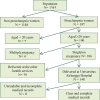Maternal Perinatal Outcomes Related to Advanced Maternal Age in Preeclampsia Pregnant Women
- PMID: 32518569
- PMCID: PMC7264866
Maternal Perinatal Outcomes Related to Advanced Maternal Age in Preeclampsia Pregnant Women
Abstract
Objective: This study aims to analyze the effect of advanced maternal age (>35 years old) in maternal and perinatal outcomes of preeclampsia women. Materials and methods: This is a retrospective cross-sectional study involved all women who were diagnosed with preeclampsia at Universitas Airlangga Hospital (Surabaya, Indonesia) between January 2016 until May 2017. The participant was divided into two groups based on maternal ages: the first group was women older than 35 years old (advanced maternal age - AMA), and the other group was 20-34 years old (reproductive age - RA). The primary outcomes of this study were the maternal and perinatal outcome. Results: There were a total of 43 AMA preeclampsia women and 105 RA preeclampsia women. The AMA preeclampsia group had a higher proportion of poor maternal outcome (the occurence of any complication: pulmonary edema, HELLP syndrome, visual impairment, post partum hemorrhage, and eclampsia) compared to RA preeclampsia group (60,5% vs 33,3%, p = 0,002; OR 3,059, CI 1,469-6,371). There was no significant difference in the other maternal complications such as HELLP syndrome, pulmonary oedema, and eclampsia. The only difference was the occurrence of postpartum haemorrhage which was higher in the AMA group (16,3% vs 4,8%, p = 0,02; OR 3,889, CI 1,161-13,031). The prevalence of cesarean delivery was more common in AMA group (53,3% vs 28,6%, p = 0,004; OR 2.825, CI 1.380-5.988). The AMA preeclampsia women also had poorer perinatal outcomes compared to the RA group (81,4% vs 59%, p = 0,009; OR 3.034 CI 1.283-7.177). AMA women had a higher risk of perinatal complication such as prematurity (OR 3.266 CI 1.269-8.406), IUGR (OR 4.474 CI 1.019-19.634), asphyxia (OR 4.263 CI 2.004-9.069), and infection (OR 2.138 CI 1.040-4.393). Conclusion: Advanced maternal age increases the risk of poorer maternal and neonatal outcomes in preeclampsia patients. The addition of advanced maternal ages in preeclampsia should raise the awareness of the health provider, tighter monitoring, complete screening and early intervention if needed to minimize the risk of complications.
Keywords: Advanced Maternal Age; Maternal Outcomes; Perinatal Outcomes; Preeclampsia.
Copyright © Vali-e-Asr Reproductive Health Research Center, Tehran University of Medical Sciences.
References
-
- Cunningham FG, Leveno KJ, Bloom SL, et al. Williams Obstetrics. 25th edition 2018.
-
- De Giacomi F, Vassallo R, Yi ES, Ryu JH. Acute Eosinophilic Pneumonia. Causes, Diagnosis, and Management. Am J Respir Crit Care Med. 2018;197:728–36. - PubMed
-
- El-Sayed AAF. Preeclampsia: A review of the pathogenesis and possible management strategies based on its pathophysiological derangements. Taiwan J Obstet Gynecol. 2017;56:593–8. - PubMed
-
- Tranquilli AL, Dekker G, Magee L, Roberts J, Sibai BM, Steyn W, et al. The classification, diagnosis and management of the hypertensivedisorders of pregnancy: A revised statement from the ISSHP. Pregnancy Hypertens . 2014;4:97–104. - PubMed
-
- Dekker G, Sibai B. Primary, secondary, and tertiary prevention ofpre-eclampsia. Lancet. 2001;357:209–15. - PubMed
LinkOut - more resources
Full Text Sources

